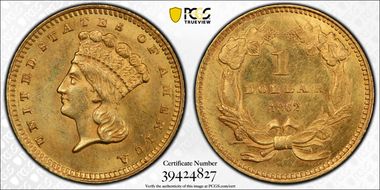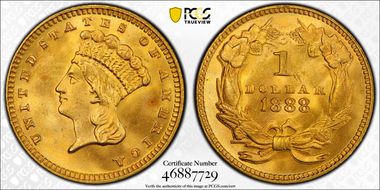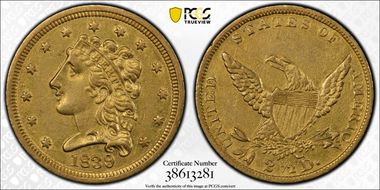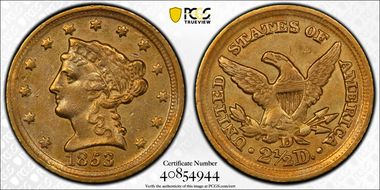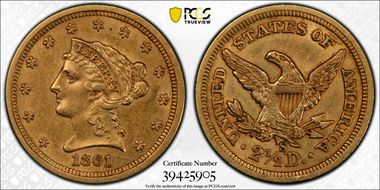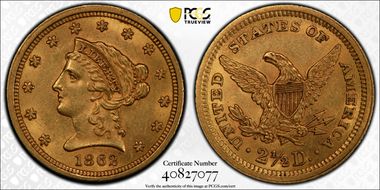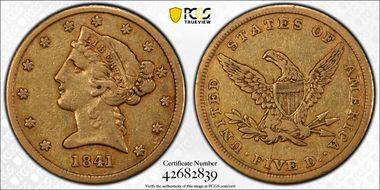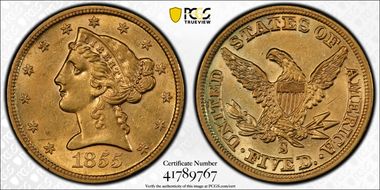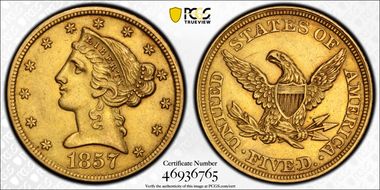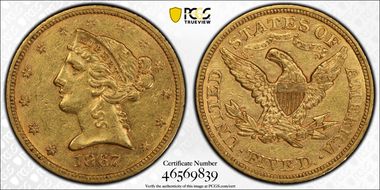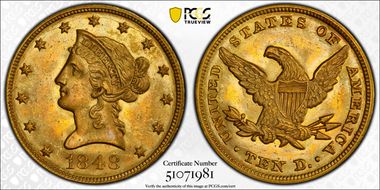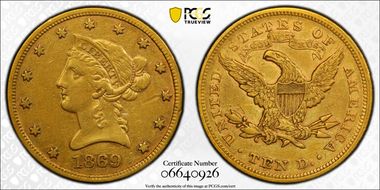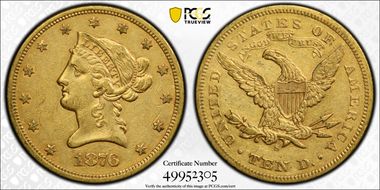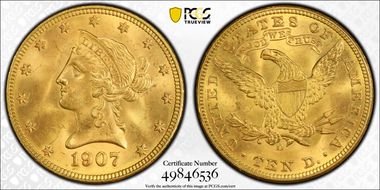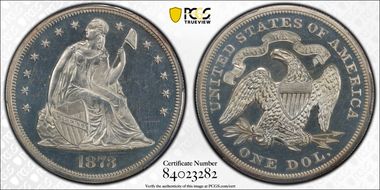[email protected] 的钱币相册
Very Rare Doubled Date. 2/24/2023 Research Update: 637 individual serial numbers (PCGS, NGC, ANACS, IGC) have now been reviewed with only 3 confirmed examples of the Double Date variety. The coin here has a significantly higher grade than the other two confirmed examples (ANACS XF40 and AU58). Two other examples (XF45 and AU55) have yet to be confirmed. ANACS lists the variety whereas PCGS and NGC do not. ANACS only lists 4 known graded pieces (1 ea, XF40, XF45, AU55 and AU58) of which I have located 2 photos, the AU58 and the XF40. The third photo is that shown above, an MS64. ANACS was not able to furnish the serial numbers of the other two pieces. The data I have is on an Excel spreadsheet and duplicate serial numbers have been removed so that the photos I examined are discrete entities. There is, however, still the possibility of duplicate coins due to resubmissions, although I believe the number is small in comparison to the aggregate total. Damaged, detail, and coins with blurry photos or without serial numbers have been excluded from my research. I also found a total of nine Double Die Obverse coins (two of which were not identified as such). 44 DDO coins are currently listed on the PCGS, NGC and ANACS websites. Q.David Bowers' "A Guide Book of Gold Dollars" and Garrett and Guth's "Encyclopedia of U.S. Gold Coins 1795-1933", make reference to the Doubled Date and the Double Die Obverse as interesting varieties, yet nothing beyond the fact that they exist. "Walter Breens' Complete Encyclopedia Of U.S. And Colonial Coins" states the coin is, "Very rare. Date first punched too high, then corrected lower." Pedigree; Maurice Storck Collection.
Very Rare Doubled Date. 2/24/2023 Research Update: 637 individual serial numbers (PCGS, NGC, ANACS, IGC) have now been reviewed with only 3 confirmed examples of the Double Date variety. The coin here has a significantly higher grade than the other two confirmed examples (ANACS XF40 and AU58). Two other examples (XF45 and AU55) have yet to be confirmed. ANACS lists the variety whereas PCGS and NGC do not. ANACS only lists 4 known graded pieces (1 ea, XF40, XF45, AU55 and AU58) of which I have located 2 photos, the AU58 and the XF40. The third photo is that shown above, an MS64. ANACS was not able to furnish the serial numbers of the other two pieces. The data I have is on an Excel spreadsheet and duplicate serial numbers have been removed so that the photos I examined are discrete entities. There is, however, still the possibility of duplicate coins due to resubmissions, although I believe the number is small in comparison to the aggregate total. Damaged, detail, and coins with blurry photos or without serial numbers have been excluded from my research. I also found a total of nine Double Die Obverse coins (two of which were not identified as such). 44 DDO coins are currently listed on the PCGS, NGC and ANACS websites. Q.David Bowers' "A Guide Book of Gold Dollars" and Garrett and Guth's "Encyclopedia of U.S. Gold Coins 1795-1933", make reference to the Doubled Date and the Double Die Obverse as interesting varieties, yet nothing beyond the fact that they exist. "Walter Breens' Complete Encyclopedia Of U.S. And Colonial Coins" states the coin is, "Very rare. Date first punched too high, then corrected lower." Pedigree; Maurice Storck Collection.
Very Rare Doubled Date. 2/24/2023 Research Update: 637 individual serial numbers (PCGS, NGC, ANACS, IGC) have now been reviewed with only 3 confirmed examples of the Double Date variety. The coin here has a significantly higher grade than the other two confirmed examples (ANACS XF40 and AU58). Two other examples (XF45 and AU55) have yet to be confirmed. ANACS lists the variety whereas PCGS and NGC do not. ANACS only lists 4 known graded pieces (1 ea, XF40, XF45, AU55 and AU58) of which I have located 2 photos, the AU58 and the XF40. The third photo is that shown above, an MS64. ANACS was not able to furnish the serial numbers of the other two pieces. The data I have is on an Excel spreadsheet and duplicate serial numbers have been removed so that the photos I examined are discrete entities. There is, however, still the possibility of duplicate coins due to resubmissions, although I believe the number is small in comparison to the aggregate total. Damaged, detail, and coins with blurry photos or without serial numbers have been excluded from my research. I also found a total of nine Double Die Obverse coins (two of which were not identified as such). 44 DDO coins are currently listed on the PCGS, NGC and ANACS websites. Q.David Bowers' "A Guide Book of Gold Dollars" and Garrett and Guth's "Encyclopedia of U.S. Gold Coins 1795-1933", make reference to the Doubled Date and the Double Die Obverse as interesting varieties, yet nothing beyond the fact that they exist. "Walter Breens' Complete Encyclopedia Of U.S. And Colonial Coins" states the coin is, "Very rare. Date first punched too high, then corrected lower." Pedigree; Maurice Storck Collection.
Very Rare Doubled Date. 2/24/2023 Research Update: 637 individual serial numbers (PCGS, NGC, ANACS, IGC) have now been reviewed with only 3 confirmed examples of the Double Date variety. The coin here has a significantly higher grade than the other two confirmed examples (ANACS XF40 and AU58). Two other examples (XF45 and AU55) have yet to be confirmed. ANACS lists the variety whereas PCGS and NGC do not. ANACS only lists 4 known graded pieces (1 ea, XF40, XF45, AU55 and AU58) of which I have located 2 photos, the AU58 and the XF40. The third photo is that shown above, an MS64. ANACS was not able to furnish the serial numbers of the other two pieces. The data I have is on an Excel spreadsheet and duplicate serial numbers have been removed so that the photos I examined are discrete entities. There is, however, still the possibility of duplicate coins due to resubmissions, although I believe the number is small in comparison to the aggregate total. Damaged, detail, and coins with blurry photos or without serial numbers have been excluded from my research. I also found a total of nine Double Die Obverse coins (two of which were not identified as such). 44 DDO coins are currently listed on the PCGS, NGC and ANACS websites. Q.David Bowers' "A Guide Book of Gold Dollars" and Garrett and Guth's "Encyclopedia of U.S. Gold Coins 1795-1933", make reference to the Doubled Date and the Double Die Obverse as interesting varieties, yet nothing beyond the fact that they exist. "Walter Breens' Complete Encyclopedia Of U.S. And Colonial Coins" states the coin is, "Very rare. Date first punched too high, then corrected lower." Pedigree; Maurice Storck Collection.
"Perfect" obverse - an early strike without the bisecting obverse crack, with full radial lines on the stars, and strong leaf/berry stems on the reverse. It also shows doubling of the legend "D STATES OF" and the left wingtip, which is also seen on PCGS MS64 SN 46092970, although not mentioned in books relevant to the date. Fields are somewhat proof-like. The reverse is rotated 10-15 degrees clock-wise from the normal position.
"Perfect" obverse - an early strike without the bisecting obverse crack, with full radial lines on the stars, and strong leaf/berry stems on the reverse. It also shows doubling of the legend "D STATES OF" and the left wingtip, which is also seen on PCGS MS64 SN 46092970, although not mentioned in books relevant to the date. Fields are somewhat proof-like. The reverse is rotated 10-15 degrees clock-wise from the normal position.
"Perfect" obverse - an early strike without the bisecting obverse crack, with full radial lines on the stars, and strong leaf/berry stems on the reverse. It also shows doubling of the legend "D STATES OF" and the left wingtip, which is also seen on PCGS MS64 SN 46092970, although not mentioned in books relevant to the date. Fields are somewhat proof-like. The reverse is rotated 10-15 degrees clock-wise from the normal position.
"Perfect" obverse - an early strike without the bisecting obverse crack, with full radial lines on the stars, and strong leaf/berry stems on the reverse. It also shows doubling of the legend "D STATES OF" and the left wingtip, which is also seen on PCGS MS64 SN 46092970, although not mentioned in books relevant to the date. Fields are somewhat proof-like. The reverse is rotated 10-15 degrees clock-wise from the normal position.
Single variety HM-1, Obverse 1, Reverse H PCGS/NGC graded population 606, including resubmissions. Haynor estimates a total population in all grades of about 450 and only 7 graded MS65 and higher, while PCGS CoinFacts estimates a survival of 400 with 9 graded MS65 or higher. The TE in UNITED appears to have been re-punched to the left. There are two small triangular remnants of the T between the top of the T and the E and there is a small triangular remnant of the E at the top leg of the E in UNITED. Also, the first A in AMERICA has a wide lower left leg and narrow upper leg between the cross bar and top, the M in AMERICA has a "toe" on the inside right serif, and the dentils above the M are very short. I have seen these peculiarities on all of the coins I've looked at in photos. Just interesting observations.
Single variety HM-1, Obverse 1, Reverse H PCGS/NGC graded population 606, including resubmissions. Haynor estimates a total population in all grades of about 450 and only 7 graded MS65 and higher, while PCGS CoinFacts estimates a survival of 400 with 9 graded MS65 or higher. The TE in UNITED appears to have been re-punched to the left. There are two small triangular remnants of the T between the top of the T and the E and there is a small triangular remnant of the E at the top leg of the E in UNITED. Also, the first A in AMERICA has a wide lower left leg and narrow upper leg between the cross bar and top, the M in AMERICA has a "toe" on the inside right serif, and the dentils above the M are very short. I have seen these peculiarities on all of the coins I've looked at in photos. Just interesting observations.
Single variety HM-1, Obverse 1, Reverse H PCGS/NGC graded population 606, including resubmissions. Haynor estimates a total population in all grades of about 450 and only 7 graded MS65 and higher, while PCGS CoinFacts estimates a survival of 400 with 9 graded MS65 or higher. The TE in UNITED appears to have been re-punched to the left. There are two small triangular remnants of the T between the top of the T and the E and there is a small triangular remnant of the E at the top leg of the E in UNITED. Also, the first A in AMERICA has a wide lower left leg and narrow upper leg between the cross bar and top, the M in AMERICA has a "toe" on the inside right serif, and the dentils above the M are very short. I have seen these peculiarities on all of the coins I've looked at in photos. Just interesting observations.
Single variety HM-1, Obverse 1, Reverse H PCGS/NGC graded population 606, including resubmissions. Haynor estimates a total population in all grades of about 450 and only 7 graded MS65 and higher, while PCGS CoinFacts estimates a survival of 400 with 9 graded MS65 or higher. The TE in UNITED appears to have been re-punched to the left. There are two small triangular remnants of the T between the top of the T and the E and there is a small triangular remnant of the E at the top leg of the E in UNITED. Also, the first A in AMERICA has a wide lower left leg and narrow upper leg between the cross bar and top, the M in AMERICA has a "toe" on the inside right serif, and the dentils above the M are very short. I have seen these peculiarities on all of the coins I've looked at in photos. Just interesting observations.
Single variety HM-1, Obverse 1, Reverse H PCGS/NGC graded population 606, including resubmissions. Haynor estimates a total population in all grades of about 450 and only 7 graded MS65 and higher, while PCGS CoinFacts estimates a survival of 400 with 9 graded MS65 or higher. The TE in UNITED appears to have been re-punched to the left. There are two small triangular remnants of the T between the top of the T and the E and there is a small triangular remnant of the E at the top leg of the E in UNITED. Also, the first A in AMERICA has a wide lower left leg and narrow upper leg between the cross bar and top, the M in AMERICA has a "toe" on the inside right serif, and the dentils above the M are very short. I have seen these peculiarities on all of the coins I've looked at in photos. Just interesting observations.
Single variety HM-1, Obverse 1, Reverse H PCGS/NGC graded population 606, including resubmissions. Haynor estimates a total population in all grades of about 450 and only 7 graded MS65 and higher, while PCGS CoinFacts estimates a survival of 400 with 9 graded MS65 or higher. The TE in UNITED appears to have been re-punched to the left. There are two small triangular remnants of the T between the top of the T and the E and there is a small triangular remnant of the E at the top leg of the E in UNITED. Also, the first A in AMERICA has a wide lower left leg and narrow upper leg between the cross bar and top, the M in AMERICA has a "toe" on the inside right serif, and the dentils above the M are very short. I have seen these peculiarities on all of the coins I've looked at in photos. Just interesting observations.
HM-1, R-4. The 8 and 9 in the date are noticeably re-punched. This coin does not show any clash marks which may indicate that this coin is from the April 1839 production run. As stated by Daryl Haynor in his book "United States Classic Gold Coins of 1834-1839", "The 1839 is by far the rarest Philadelphia Classic Gold quarter eagle, neck and neck with the 1838-C for overall supremacy. Garret and Guth, in their "Encyclopedia Of U.S. Gold Coins 1795-1933" suggest, "The 1839 quarter eagle is the sleeper rarity of the series. Although the mintage of this date is more than three times as high as that of the 1838-C issue, there have been fewer 1839 examples graded than any of other date... the raw numbers are an indication that this date is much rarer than is generally perceived." David Aker's Auction Analysis of Quarter Eagles (1975) also maintains the rarity by stating, "This is certainly one of the most underrated quarter eagles of this type. The auction records clearly indicate that the 1839/8 is nearly as rare as the lower mintage 1838-C or 1839/8-D." His average grade for the date is VF-37.
HM-1, R-4. The 8 and 9 in the date are noticeably re-punched. This coin does not show any clash marks which may indicate that this coin is from the April 1839 production run. As stated by Daryl Haynor in his book "United States Classic Gold Coins of 1834-1839", "The 1839 is by far the rarest Philadelphia Classic Gold quarter eagle, neck and neck with the 1838-C for overall supremacy. Garret and Guth, in their "Encyclopedia Of U.S. Gold Coins 1795-1933" suggest, "The 1839 quarter eagle is the sleeper rarity of the series. Although the mintage of this date is more than three times as high as that of the 1838-C issue, there have been fewer 1839 examples graded than any of other date... the raw numbers are an indication that this date is much rarer than is generally perceived." David Aker's Auction Analysis of Quarter Eagles (1975) also maintains the rarity by stating, "This is certainly one of the most underrated quarter eagles of this type. The auction records clearly indicate that the 1839/8 is nearly as rare as the lower mintage 1838-C or 1839/8-D." His average grade for the date is VF-37.
HM-1, R-4. The 8 and 9 in the date are noticeably re-punched. This coin does not show any clash marks which may indicate that this coin is from the April 1839 production run. As stated by Daryl Haynor in his book "United States Classic Gold Coins of 1834-1839", "The 1839 is by far the rarest Philadelphia Classic Gold quarter eagle, neck and neck with the 1838-C for overall supremacy. Garret and Guth, in their "Encyclopedia Of U.S. Gold Coins 1795-1933" suggest, "The 1839 quarter eagle is the sleeper rarity of the series. Although the mintage of this date is more than three times as high as that of the 1838-C issue, there have been fewer 1839 examples graded than any of other date... the raw numbers are an indication that this date is much rarer than is generally perceived." David Aker's Auction Analysis of Quarter Eagles (1975) also maintains the rarity by stating, "This is certainly one of the most underrated quarter eagles of this type. The auction records clearly indicate that the 1839/8 is nearly as rare as the lower mintage 1838-C or 1839/8-D." His average grade for the date is VF-37.
Haynor/McCloskey variety HM-1, R3+, Winters variety 2 (3-B) Obverse - Recut 39 in the date. Die cracks are evident from star 2, star 9 and the 3 in the date, and all converge toward the center. Reverse - Die cracks appear at the left facing wing tip, under the A in STATES, and through the 2 in the denomination.
Rare (50-60 known per PCGS). As Garrett and Guth state in their "Encyclopedia Of U.S. Gold Coins 1795-1933", "As the tiny mintage suggests, the 1842 Liberty Head quarter eagle is a major rarity in any grade...A review of other auction records reveals that this date is seldom offered for sale in any grade... The 1842 quarter eagle is still very rare, much more so than many of the more popular Southern mint issues." David Akers' "An Analysis Of Auction Records - Volume II - Quarter Eagles" his average grade at the time (1975) was VF29.
Rare (50-60 known per PCGS). As Garrett and Guth state in their "Encyclopedia Of U.S. Gold Coins 1795-1933", "As the tiny mintage suggests, the 1842 Liberty Head quarter eagle is a major rarity in any grade...A review of other auction records reveals that this date is seldom offered for sale in any grade... The 1842 quarter eagle is still very rare, much more so than many of the more popular Southern mint issues." David Akers' "An Analysis Of Auction Records - Volume II - Quarter Eagles" his average grade at the time (1975) was VF29.
A single variety exists - Winter 17-N Douglas Winter's "Gold Coins of the Dahlonega Mint 1838-1861" also indicates the rarity is 7th of 20. He states, "The 1853-D quarter eagle is scarce in all grades. It is seen most often in VF to XF range..." Garrett and Guth's "Encyclopedia of U.S. Gold Coins 1795-1933" echos the rarity, stating, "As the tiny mintage suggests, the 1853-D quarter eagle must be considered rare in any grade. Perhaps fewer than 100 coins still survive in all grades."
A single variety exists - Winter 17-N Douglas Winter's "Gold Coins of the Dahlonega Mint 1838-1861" also indicates the rarity is 7th of 20. He states, "The 1853-D quarter eagle is scarce in all grades. It is seen most often in VF to XF range..." Garrett and Guth's "Encyclopedia of U.S. Gold Coins 1795-1933" echos the rarity, stating, "As the tiny mintage suggests, the 1853-D quarter eagle must be considered rare in any grade. Perhaps fewer than 100 coins still survive in all grades."
A single variety exists - Winter 17-N Douglas Winter's "Gold Coins of the Dahlonega Mint 1838-1861" also indicates the rarity is 7th of 20. He states, "The 1853-D quarter eagle is scarce in all grades. It is seen most often in VF to XF range..." Garrett and Guth's "Encyclopedia of U.S. Gold Coins 1795-1933" echos the rarity, stating, "As the tiny mintage suggests, the 1853-D quarter eagle must be considered rare in any grade. Perhaps fewer than 100 coins still survive in all grades."
A single variety exists - Winter 17-N Douglas Winter's "Gold Coins of the Dahlonega Mint 1838-1861" also indicates the rarity is 7th of 20. He states, "The 1853-D quarter eagle is scarce in all grades. It is seen most often in VF to XF range..." Garrett and Guth's "Encyclopedia of U.S. Gold Coins 1795-1933" echos the rarity, stating, "As the tiny mintage suggests, the 1853-D quarter eagle must be considered rare in any grade. Perhaps fewer than 100 coins still survive in all grades."
A single variety exists - Winter 17-N Douglas Winter's "Gold Coins of the Dahlonega Mint 1838-1861" also indicates the rarity is 7th of 20. He states, "The 1853-D quarter eagle is scarce in all grades. It is seen most often in VF to XF range..." Garrett and Guth's "Encyclopedia of U.S. Gold Coins 1795-1933" echos the rarity, stating, "As the tiny mintage suggests, the 1853-D quarter eagle must be considered rare in any grade. Perhaps fewer than 100 coins still survive in all grades."
Garrett and Guth state in their "Encyclopedia of U.S. Gold Coins 1795-1933", "The 1861-S quarter eagle is another issue with a moderately low mintage that was heavily circulated and has few survivors. This date is usually seen heavily worn and becomes increasingly rare in higher grades... The 1861-S quarter eagle does not garner much attention, but can be extremely difficult to locate in any grade." "Walter Breen's Complete Encyclopedia of U.S. And Colonial Coins" asserts, "'Type 1' rev. Very scarce. One obv. shipped Nov. 1860, one June 1861: leftover revs. from 1856. Much rarer in all grades than mintage figure suggests; usually weak VF, Ex. rare in EF, unknown UNC." Since his book was published in 1988, as many as 11 uncirculated coins may exist although PCGS suggests only 4 in MS60 and above. I have found 3 distinct reverse dies were used, identified by the location of the mint mark. The first has the mint mark slanted right with the lower serif of the S almost touching the fraction bar (see PCGS website MS62+ photo). The second is more upright and positioned above the upper serif of the D (see PCGS website AU58 photos). The third has the mint mark positioned left between the 1 in the fraction and the fraction bar (see NGC website sn 3516516-010 AU55)(This appears to be the rarest of the three and its the best photo I could find - sorry). This coin has the upright mint mark above the D upper serif. There is also a contact mark (point) between stars 7 and 8. Pedigree: Maurice Storck Collection (2020)
Garrett and Guth state in their "Encyclopedia of U.S. Gold Coins 1795-1933", "The 1861-S quarter eagle is another issue with a moderately low mintage that was heavily circulated and has few survivors. This date is usually seen heavily worn and becomes increasingly rare in higher grades... The 1861-S quarter eagle does not garner much attention, but can be extremely difficult to locate in any grade." "Walter Breen's Complete Encyclopedia of U.S. And Colonial Coins" asserts, "'Type 1' rev. Very scarce. One obv. shipped Nov. 1860, one June 1861: leftover revs. from 1856. Much rarer in all grades than mintage figure suggests; usually weak VF, Ex. rare in EF, unknown UNC." Since his book was published in 1988, as many as 11 uncirculated coins may exist although PCGS suggests only 4 in MS60 and above. I have found 3 distinct reverse dies were used, identified by the location of the mint mark. The first has the mint mark slanted right with the lower serif of the S almost touching the fraction bar (see PCGS website MS62+ photo). The second is more upright and positioned above the upper serif of the D (see PCGS website AU58 photos). The third has the mint mark positioned left between the 1 in the fraction and the fraction bar (see NGC website sn 3516516-010 AU55)(This appears to be the rarest of the three and its the best photo I could find - sorry). This coin has the upright mint mark above the D upper serif. There is also a contact mark (point) between stars 7 and 8. Pedigree: Maurice Storck Collection (2020)
Garrett and Guth state in their "Encyclopedia of U.S. Gold Coins 1795-1933", "The 1861-S quarter eagle is another issue with a moderately low mintage that was heavily circulated and has few survivors. This date is usually seen heavily worn and becomes increasingly rare in higher grades... The 1861-S quarter eagle does not garner much attention, but can be extremely difficult to locate in any grade." "Walter Breen's Complete Encyclopedia of U.S. And Colonial Coins" asserts, "'Type 1' rev. Very scarce. One obv. shipped Nov. 1860, one June 1861: leftover revs. from 1856. Much rarer in all grades than mintage figure suggests; usually weak VF, Ex. rare in EF, unknown UNC." Since his book was published in 1988, as many as 11 uncirculated coins may exist although PCGS suggests only 4 in MS60 and above. I have found 3 distinct reverse dies were used, identified by the location of the mint mark. The first has the mint mark slanted right with the lower serif of the S almost touching the fraction bar (see PCGS website MS62+ photo). The second is more upright and positioned above the upper serif of the D (see PCGS website AU58 photos). The third has the mint mark positioned left between the 1 in the fraction and the fraction bar (see NGC website sn 3516516-010 AU55)(This appears to be the rarest of the three and its the best photo I could find - sorry). This coin has the upright mint mark above the D upper serif. There is also a contact mark (point) between stars 7 and 8. Pedigree: Maurice Storck Collection (2020)
Garrett and Guth in their "Encyclopedia of U.S. Gold Coins 1795-1933" state, "The mintage of the 1862 quarter eagle dropped considerably at the Philadelphia Mint from the previous year. Even with a rather substantial production of nearly 100,000 coins, this date is scarce in all grades. The 1862 quarter eagle is many, many times rarer than the 1861. Gold coinage after the start of the Civil War did not circulate with regularity, and many great rarities were produced during this era. Most of the examples seen of this date are well struck, some with die clashes visible on one or both sides." Subtle die clashing on this coin can be seen with the aid of a loupe.
Garrett and Guth in their "Encyclopedia of U.S. Gold Coins 1795-1933" state, "The mintage of the 1862 quarter eagle dropped considerably at the Philadelphia Mint from the previous year. Even with a rather substantial production of nearly 100,000 coins, this date is scarce in all grades. The 1862 quarter eagle is many, many times rarer than the 1861. Gold coinage after the start of the Civil War did not circulate with regularity, and many great rarities were produced during this era. Most of the examples seen of this date are well struck, some with die clashes visible on one or both sides." Subtle die clashing on this coin can be seen with the aid of a loupe.
Garrett and Guth in their "Encyclopedia of U.S. Gold Coins 1795-1933" state, "The mintage of the 1862 quarter eagle dropped considerably at the Philadelphia Mint from the previous year. Even with a rather substantial production of nearly 100,000 coins, this date is scarce in all grades. The 1862 quarter eagle is many, many times rarer than the 1861. Gold coinage after the start of the Civil War did not circulate with regularity, and many great rarities were produced during this era. Most of the examples seen of this date are well struck, some with die clashes visible on one or both sides." Subtle die clashing on this coin can be seen with the aid of a loupe.
PCGS estimated survival of 80. Walter Breen's monograph "New Varieties of $1, $2.50 and $5 US Gold" pg 8, comments "One of the most undervalued of all S mint quarter eagles; fewer are around than the 1875 S or 76 S." This is still true today for these two dates with the 75-S at 326 graded and the 76-S at 272 graded. Breen's "Complete Encyclopedia" lists the 1862-S as "Very Rare", "Usually VF; Ex rare above", "S-Mint coins continue to have "Type 1" rev. through 1876". David Akers' "United States Gold Coins - An Auction Analysis of Auction Records - Volume II - Quarter Eagles 1796-1929" echoes the sentiment, "Very rare in all grades and extremely underrated. This date is seldom available in any condition and its 24 appearances in 226 auctions places it in tenth in the entire quarter eagle series according to rarity by number of appearances... Without a doubt, the 1862-S is one of the major "sleepers" in the entire quarter eagle series and any specimen grading EF or better should be considered highly desirable." His average grade at the time (1975) shows an average grade of VF34. Garrett and Guth's "Encyclopedia Of U.S. Gold Coins 1795-1933" comments, "The 1862-S quarter eagle was struck in far fewer numbers than coins of previous years at the San Francisco Mint. This date is very rare an any grade and extremely rare in Mint State. Most of the 1862-S quarter eagles are well worn or damaged... The Smithsonian example is About Uncirculated and is among the finest survivors for the date." The Smithsonian coin is graded AU50
PCGS estimated survival of 80. Walter Breen's monograph "New Varieties of $1, $2.50 and $5 US Gold" pg 8, comments "One of the most undervalued of all S mint quarter eagles; fewer are around than the 1875 S or 76 S." This is still true today for these two dates with the 75-S at 326 graded and the 76-S at 272 graded. Breen's "Complete Encyclopedia" lists the 1862-S as "Very Rare", "Usually VF; Ex rare above", "S-Mint coins continue to have "Type 1" rev. through 1876". David Akers' "United States Gold Coins - An Auction Analysis of Auction Records - Volume II - Quarter Eagles 1796-1929" echoes the sentiment, "Very rare in all grades and extremely underrated. This date is seldom available in any condition and its 24 appearances in 226 auctions places it in tenth in the entire quarter eagle series according to rarity by number of appearances... Without a doubt, the 1862-S is one of the major "sleepers" in the entire quarter eagle series and any specimen grading EF or better should be considered highly desirable." His average grade at the time (1975) shows an average grade of VF34. Garrett and Guth's "Encyclopedia Of U.S. Gold Coins 1795-1933" comments, "The 1862-S quarter eagle was struck in far fewer numbers than coins of previous years at the San Francisco Mint. This date is very rare an any grade and extremely rare in Mint State. Most of the 1862-S quarter eagles are well worn or damaged... The Smithsonian example is About Uncirculated and is among the finest survivors for the date." The Smithsonian coin is graded AU50
PCGS estimated survival of 80. Walter Breen's monograph "New Varieties of $1, $2.50 and $5 US Gold" pg 8, comments "One of the most undervalued of all S mint quarter eagles; fewer are around than the 1875 S or 76 S." This is still true today for these two dates with the 75-S at 326 graded and the 76-S at 272 graded. Breen's "Complete Encyclopedia" lists the 1862-S as "Very Rare", "Usually VF; Ex rare above", "S-Mint coins continue to have "Type 1" rev. through 1876". David Akers' "United States Gold Coins - An Auction Analysis of Auction Records - Volume II - Quarter Eagles 1796-1929" echoes the sentiment, "Very rare in all grades and extremely underrated. This date is seldom available in any condition and its 24 appearances in 226 auctions places it in tenth in the entire quarter eagle series according to rarity by number of appearances... Without a doubt, the 1862-S is one of the major "sleepers" in the entire quarter eagle series and any specimen grading EF or better should be considered highly desirable." His average grade at the time (1975) shows an average grade of VF34. Garrett and Guth's "Encyclopedia Of U.S. Gold Coins 1795-1933" comments, "The 1862-S quarter eagle was struck in far fewer numbers than coins of previous years at the San Francisco Mint. This date is very rare an any grade and extremely rare in Mint State. Most of the 1862-S quarter eagles are well worn or damaged... The Smithsonian example is About Uncirculated and is among the finest survivors for the date." The Smithsonian coin is graded AU50
PCGS estimated survival of 80. Walter Breen's monograph "New Varieties of $1, $2.50 and $5 US Gold" pg 8, comments "One of the most undervalued of all S mint quarter eagles; fewer are around than the 1875 S or 76 S." This is still true today for these two dates with the 75-S at 326 graded and the 76-S at 272 graded. Breen's "Complete Encyclopedia" lists the 1862-S as "Very Rare", "Usually VF; Ex rare above", "S-Mint coins continue to have "Type 1" rev. through 1876". David Akers' "United States Gold Coins - An Auction Analysis of Auction Records - Volume II - Quarter Eagles 1796-1929" echoes the sentiment, "Very rare in all grades and extremely underrated. This date is seldom available in any condition and its 24 appearances in 226 auctions places it in tenth in the entire quarter eagle series according to rarity by number of appearances... Without a doubt, the 1862-S is one of the major "sleepers" in the entire quarter eagle series and any specimen grading EF or better should be considered highly desirable." His average grade at the time (1975) shows an average grade of VF34. Garrett and Guth's "Encyclopedia Of U.S. Gold Coins 1795-1933" comments, "The 1862-S quarter eagle was struck in far fewer numbers than coins of previous years at the San Francisco Mint. This date is very rare an any grade and extremely rare in Mint State. Most of the 1862-S quarter eagles are well worn or damaged... The Smithsonian example is About Uncirculated and is among the finest survivors for the date." The Smithsonian coin is graded AU50
Pedigree: Millenium Collection, Toro Collection (2021). Garrett and Guth's "Encyclopedia of U.S. Gold Coins 1795-1933" states, "The 1867 quarter eagle is scarce, if not truly rare, in all grades. Most of the examples seen are circulated to some degree, and this date is very rare in full Mint State... Most of the high-grade examples seen have at least partially prooflike surfaces." They also indicate that the Finest Smithsonian Institution specimen is an AU-55 (as of 2008). David Akers' "United States Gold Coins - An Analysis of Auction records - Volume II Quarter Eagles 1796-1929" (1975) comments, "Very rare in all grades..." PCGS estimates the survival in all grades at 50 This coin does exhibit prooflike surfaces in protected areas.
Pedigree: Millenium Collection, Toro Collection (2021). Garrett and Guth's "Encyclopedia of U.S. Gold Coins 1795-1933" states, "The 1867 quarter eagle is scarce, if not truly rare, in all grades. Most of the examples seen are circulated to some degree, and this date is very rare in full Mint State... Most of the high-grade examples seen have at least partially prooflike surfaces." They also indicate that the Finest Smithsonian Institution specimen is an AU-55 (as of 2008). David Akers' "United States Gold Coins - An Analysis of Auction records - Volume II Quarter Eagles 1796-1929" (1975) comments, "Very rare in all grades..." PCGS estimates the survival in all grades at 50 This coin does exhibit prooflike surfaces in protected areas.
Garrett and Guth's "Encyclopedia of U.S. Gold Coins" comments, "Quarter eagles from the San Francisco Mint of this era all share common themes - they are usually found well worn and are rare in high grade. The 1869-S is no exception, as most of the coins are found for this year are relatively low grade." David Akers, in his Auction Analysis of 1975 suggested, "Scarce as a date... Most specimens I have seen were very bluntly struck and have relatively little detail on the hair around Liberty's face or on the eagle's right leg and neck... grossly underpriced, particularly in choice condition." He gave the 1869-S quarter eagle an average grade of VF30 although the current graded population suggest a better average would be in the VF45-AU50 range.
Garrett and Guth's "Encyclopedia of U.S. Gold Coins" comments, "Quarter eagles from the San Francisco Mint of this era all share common themes - they are usually found well worn and are rare in high grade. The 1869-S is no exception, as most of the coins are found for this year are relatively low grade." David Akers, in his Auction Analysis of 1975 suggested, "Scarce as a date... Most specimens I have seen were very bluntly struck and have relatively little detail on the hair around Liberty's face or on the eagle's right leg and neck... grossly underpriced, particularly in choice condition." He gave the 1869-S quarter eagle an average grade of VF30 although the current graded population suggest a better average would be in the VF45-AU50 range.
As Garrett and Guth suggest in their "Encyclopedia Of U.S. Gold Coins 1795-1933", "This date is another in a series of very low-production issues... The 1883 quarter eagle is a very rare coin in all grades... As usual for the low-mintage issues, most 1883 quarter eagles are seen with deeply reflective, prooflike surfaces." An interesting note regarding the 1883 is the die clash marks below the R in LIBERTY which end as a rectangular mark inside Liberty's ear (vertical shield lines [pale gules]). From what I have been able to discern, Proof coins do not have this die clash while business strikes do. This may be a diagnostic for proof versus business strikes, although it is an area of research that I have not yet been able to devote time to. Also the Y in LIBERTY appears to have been repunched low. The survival estimate listed on the PCGS website seems to be out of line with other coins in the series. With a graded population of 166 by PCGS and NGC (including resubmissions) the estimate of 250 total surviving appears inflated. Maybe a typo? 150 (R7.5) would seem to be a more realistic number especially with a total mintage of only 1920 business strikes.
As Garrett and Guth suggest in their "Encyclopedia Of U.S. Gold Coins 1795-1933", "This date is another in a series of very low-production issues... The 1883 quarter eagle is a very rare coin in all grades... As usual for the low-mintage issues, most 1883 quarter eagles are seen with deeply reflective, prooflike surfaces." An interesting note regarding the 1883 is the die clash marks below the R in LIBERTY which end as a rectangular mark inside Liberty's ear (vertical shield lines [pale gules]). From what I have been able to discern, Proof coins do not have this die clash while business strikes do. This may be a diagnostic for proof versus business strikes, although it is an area of research that I have not yet been able to devote time to. Also the Y in LIBERTY appears to have been repunched low. The survival estimate listed on the PCGS website seems to be out of line with other coins in the series. With a graded population of 166 by PCGS and NGC (including resubmissions) the estimate of 250 total surviving appears inflated. Maybe a typo? 150 (R7.5) would seem to be a more realistic number especially with a total mintage of only 1920 business strikes.
As Garrett and Guth suggest in their "Encyclopedia Of U.S. Gold Coins 1795-1933", "This date is another in a series of very low-production issues... The 1883 quarter eagle is a very rare coin in all grades... As usual for the low-mintage issues, most 1883 quarter eagles are seen with deeply reflective, prooflike surfaces." An interesting note regarding the 1883 is the die clash marks below the R in LIBERTY which end as a rectangular mark inside Liberty's ear (vertical shield lines [pale gules]). From what I have been able to discern, Proof coins do not have this die clash while business strikes do. This may be a diagnostic for proof versus business strikes, although it is an area of research that I have not yet been able to devote time to. Also the Y in LIBERTY appears to have been repunched low. The survival estimate listed on the PCGS website seems to be out of line with other coins in the series. With a graded population of 166 by PCGS and NGC (including resubmissions) the estimate of 250 total surviving appears inflated. Maybe a typo? 150 (R7.5) would seem to be a more realistic number especially with a total mintage of only 1920 business strikes.
Garrett and Guth in their "Encyclopedia of U.S. Gold Coins" comment, "As the low mintage of just over 15,800 coins suggest, the 1841 half eagle is scarce. In circulated condition this date is just about as rare as many of the branch-mint coins of the era." David Akers, in his book "United States Gold Coins - An Analysis of Auction Records - Volume IV - Half Eagles" describes the 1841 half eagle as "...very rare in all grades. It has appeared at auction less often than any of the 1839 or 1840 coins and also less often than the 1841-C or 1841-D." Walter Breen's monograph "Varieties of United States Half Eagles" (1964-1966) states, "There are no discernable cracks on specimens so far seen by me." The coin above shows significant cracking on the reverse die and is possibly one of the last batch of 3,633 coins delivered on Dec. 31, 1841 (pg. 5). It is interesting to note that PCGS CoinFacts estimates a surviving population of 1841 half eagles at 150, yet the current graded population by both PCGS and NGC is only 134, including resubmissions. A typo by PCGS? Should the estimated population be instead 100 or less?
First obtainable San Fransisco half eagle. Diagnostic (die chip?) at star 13 dentils is common to all 1855-S half eagles I've seen. Walter Breen in his monographs and encyclopedia suggests that multiple obverses exist with dates high or very high, however I haven't seen his " date placed very high, with tops of 5's weak, and 1 almost touching bust..." variety. The mint mark is located between the VE in FIVE although there appears to be slight differences in tilt and again from what I've seen this tilt difference is miniscule at most. Garrett and Guth in their "Encyclopedia of U.S. Gold Coins" state, "The moderately high mintage of 61,000 coins fails to truly convey the rarity of the 1855-S half eagle. This issue saw extensive commercial usage and most of the surviving coins are heavily circulated or damaged."
First obtainable San Fransisco half eagle. Diagnostic (die chip?) at star 13 dentils is common to all 1855-S half eagles I've seen. Walter Breen in his monographs and encyclopedia suggests that multiple obverses exist with dates high or very high, however I haven't seen his " date placed very high, with tops of 5's weak, and 1 almost touching bust..." variety. The mint mark is located between the VE in FIVE although there appears to be slight differences in tilt and again from what I've seen this tilt difference is miniscule at most. Garrett and Guth in their "Encyclopedia of U.S. Gold Coins" state, "The moderately high mintage of 61,000 coins fails to truly convey the rarity of the 1855-S half eagle. This issue saw extensive commercial usage and most of the surviving coins are heavily circulated or damaged."
First obtainable San Fransisco half eagle. Diagnostic (die chip?) at star 13 dentils is common to all 1855-S half eagles I've seen. Walter Breen in his monographs and encyclopedia suggests that multiple obverses exist with dates high or very high, however I haven't seen his " date placed very high, with tops of 5's weak, and 1 almost touching bust..." variety. The mint mark is located between the VE in FIVE although there appears to be slight differences in tilt and again from what I've seen this tilt difference is miniscule at most. Garrett and Guth in their "Encyclopedia of U.S. Gold Coins" state, "The moderately high mintage of 61,000 coins fails to truly convey the rarity of the 1855-S half eagle. This issue saw extensive commercial usage and most of the surviving coins are heavily circulated or damaged."
First obtainable San Fransisco half eagle. Diagnostic (die chip?) at star 13 dentils is common to all 1855-S half eagles I've seen. Walter Breen in his monographs and encyclopedia suggests that multiple obverses exist with dates high or very high, however I haven't seen his " date placed very high, with tops of 5's weak, and 1 almost touching bust..." variety. The mint mark is located between the VE in FIVE although there appears to be slight differences in tilt and again from what I've seen this tilt difference is miniscule at most. Garrett and Guth in their "Encyclopedia of U.S. Gold Coins" state, "The moderately high mintage of 61,000 coins fails to truly convey the rarity of the 1855-S half eagle. This issue saw extensive commercial usage and most of the surviving coins are heavily circulated or damaged."
First obtainable San Fransisco half eagle. Diagnostic (die chip?) at star 13 dentils is common to all 1855-S half eagles I've seen. Walter Breen in his monographs and encyclopedia suggests that multiple obverses exist with dates high or very high, however I haven't seen his " date placed very high, with tops of 5's weak, and 1 almost touching bust..." variety. The mint mark is located between the VE in FIVE although there appears to be slight differences in tilt and again from what I've seen this tilt difference is miniscule at most. Garrett and Guth in their "Encyclopedia of U.S. Gold Coins" state, "The moderately high mintage of 61,000 coins fails to truly convey the rarity of the 1855-S half eagle. This issue saw extensive commercial usage and most of the surviving coins are heavily circulated or damaged."
Garrett and Guth in their "Encyclopedia Of U.S. Gold Coins 1795-1933" states, "The mintage of 98,188 examples for the 1857 half eagle is on the low side for the Philadelphia Mint issues of the era. This issue is scarce in any grade and very rare in full Mint State." David Akers Auction Analysis "Volume IV, Half Eagles 1795-1929" comments, "The 1857 is a very scarce coin in any condition and it is less often seen than some of the more popular mint marked coins of the 1840' and 1850's." His average grade for the 1857 half eagle is EF-42.
Variety 43-HH as described in Douglas Winter's "Gold Coins of the Dahl0nega Mint 1838-1861". He has the overall rarity at 17th of 26, and he describes the "SURFACES: The 1858-D half eagle is difficult to locate with clean surfaces. Even higher grade examples show numerous abrasions. The fields are sometimes rough or slightly granular due to poorly prepared planchets."
Variety 43-HH as described in Douglas Winter's "Gold Coins of the Dahl0nega Mint 1838-1861". He has the overall rarity at 17th of 26, and he describes the "SURFACES: The 1858-D half eagle is difficult to locate with clean surfaces. Even higher grade examples show numerous abrasions. The fields are sometimes rough or slightly granular due to poorly prepared planchets."
Variety 43-HH as described in Douglas Winter's "Gold Coins of the Dahl0nega Mint 1838-1861". He has the overall rarity at 17th of 26, and he describes the "SURFACES: The 1858-D half eagle is difficult to locate with clean surfaces. Even higher grade examples show numerous abrasions. The fields are sometimes rough or slightly granular due to poorly prepared planchets."
Variety 43-HH as described in Douglas Winter's "Gold Coins of the Dahl0nega Mint 1838-1861". He has the overall rarity at 17th of 26, and he describes the "SURFACES: The 1858-D half eagle is difficult to locate with clean surfaces. Even higher grade examples show numerous abrasions. The fields are sometimes rough or slightly granular due to poorly prepared planchets."
Garrett and Guth's "Encyclopedia of U.S. Gold Coins" states, "The 1867 half eagle has nearly the same mintage as the 1866 issue and is of similar rarity. This date is very rare in all grades, with the typical specimen being heavily circulated." Breen considers the 1867 half eagle to be "Very rare" in his "Complete Encyclopedia of U.S. and Colonial Coins" David Aker's "Analysis of Auction Records - Volume IV - Half Eagles" opines, "With respect to both mintage and frequency of appearance, the 1867 is of almost identical rarity to the 1866. The known business strikes of this date are almost always well worn and VF or EF specimens are typical." His average grade is listed as VF-33.
Garrett and Guth's "Encyclopedia of U.S. Gold Coins" states, "The 1867 half eagle has nearly the same mintage as the 1866 issue and is of similar rarity. This date is very rare in all grades, with the typical specimen being heavily circulated." Breen considers the 1867 half eagle to be "Very rare" in his "Complete Encyclopedia of U.S. and Colonial Coins" David Aker's "Analysis of Auction Records - Volume IV - Half Eagles" opines, "With respect to both mintage and frequency of appearance, the 1867 is of almost identical rarity to the 1866. The known business strikes of this date are almost always well worn and VF or EF specimens are typical." His average grade is listed as VF-33.
Garrett and Guth's "Encyclopedia of U.S. Gold Coins" states, "The 1867 half eagle has nearly the same mintage as the 1866 issue and is of similar rarity. This date is very rare in all grades, with the typical specimen being heavily circulated." Breen considers the 1867 half eagle to be "Very rare" in his "Complete Encyclopedia of U.S. and Colonial Coins" David Aker's "Analysis of Auction Records - Volume IV - Half Eagles" opines, "With respect to both mintage and frequency of appearance, the 1867 is of almost identical rarity to the 1866. The known business strikes of this date are almost always well worn and VF or EF specimens are typical." His average grade is listed as VF-33.
Rarity 17th of 21 per Douglas Winter's "Gold Coins of the New Orleans Mint 1839-1909". Variety 2 (2-A), Obverse - the 1 in the date is equidistant between truncation and dentils, 3 closer to dentils than truncation. Reverse - Mintmark positioned over left side of N in TEN.
Rarity 17th of 21 per Douglas Winter's "Gold Coins of the New Orleans Mint 1839-1909". Variety 2 (2-A), Obverse - the 1 in the date is equidistant between truncation and dentils, 3 closer to dentils than truncation. Reverse - Mintmark positioned over left side of N in TEN.
Rarity 17th of 21 per Douglas Winter's "Gold Coins of the New Orleans Mint 1839-1909". Variety 2 (2-A), Obverse - the 1 in the date is equidistant between truncation and dentils, 3 closer to dentils than truncation. Reverse - Mintmark positioned over left side of N in TEN.
Rarity 17th of 21 per Douglas Winter's "Gold Coins of the New Orleans Mint 1839-1909". Variety 2 (2-A), Obverse - the 1 in the date is equidistant between truncation and dentils, 3 closer to dentils than truncation. Reverse - Mintmark positioned over left side of N in TEN.
Per David Akers' "United States Gold Coins - An Analysis Of Auction Records - Volume V - Eagles 1795-1933" (1980), This date is just one of the many grossly underrated dates in the Liberty Head Eagle series. It is very rare and difficult to obtain in any condition and, when located, VF or EF is about all one can expect." Garrett and Guth's "Encyclopedia Of U.S. Gold Coins 1795-1933" (2008) maintains, "The 1845 eagle is a great, low-mintage date whose rarity has withstood the test of time. Certainly, it is not as rare as the 1844, but it compares favorably with the 1846 and 1849-O. The vast majority of 1845 eagles are in circulated condition, mostly EF or worse, rarely in AU, and almost never in Mint State." Q. David Bowers' "Official Red Book - A Guide To Gold Eagle Coins" (2017) states, "As is true of all other eagles of this era, VF and EF are par for grades usually seen, with VF predominating."
Per David Akers' "United States Gold Coins - An Analysis Of Auction Records - Volume V - Eagles 1795-1933" (1980), This date is just one of the many grossly underrated dates in the Liberty Head Eagle series. It is very rare and difficult to obtain in any condition and, when located, VF or EF is about all one can expect." Garrett and Guth's "Encyclopedia Of U.S. Gold Coins 1795-1933" (2008) maintains, "The 1845 eagle is a great, low-mintage date whose rarity has withstood the test of time. Certainly, it is not as rare as the 1844, but it compares favorably with the 1846 and 1849-O. The vast majority of 1845 eagles are in circulated condition, mostly EF or worse, rarely in AU, and almost never in Mint State." Q. David Bowers' "Official Red Book - A Guide To Gold Eagle Coins" (2017) states, "As is true of all other eagles of this era, VF and EF are par for grades usually seen, with VF predominating."
Per David Akers' "United States Gold Coins - An Analysis Of Auction Records - Volume V - Eagles 1795-1933" (1980), This date is just one of the many grossly underrated dates in the Liberty Head Eagle series. It is very rare and difficult to obtain in any condition and, when located, VF or EF is about all one can expect." Garrett and Guth's "Encyclopedia Of U.S. Gold Coins 1795-1933" (2008) maintains, "The 1845 eagle is a great, low-mintage date whose rarity has withstood the test of time. Certainly, it is not as rare as the 1844, but it compares favorably with the 1846 and 1849-O. The vast majority of 1845 eagles are in circulated condition, mostly EF or worse, rarely in AU, and almost never in Mint State." Q. David Bowers' "Official Red Book - A Guide To Gold Eagle Coins" (2017) states, "As is true of all other eagles of this era, VF and EF are par for grades usually seen, with VF predominating."
Per David Akers' "United States Gold Coins - An Analysis Of Auction Records - Volume V - Eagles 1795-1933" (1980), This date is just one of the many grossly underrated dates in the Liberty Head Eagle series. It is very rare and difficult to obtain in any condition and, when located, VF or EF is about all one can expect." Garrett and Guth's "Encyclopedia Of U.S. Gold Coins 1795-1933" (2008) maintains, "The 1845 eagle is a great, low-mintage date whose rarity has withstood the test of time. Certainly, it is not as rare as the 1844, but it compares favorably with the 1846 and 1849-O. The vast majority of 1845 eagles are in circulated condition, mostly EF or worse, rarely in AU, and almost never in Mint State." Q. David Bowers' "Official Red Book - A Guide To Gold Eagle Coins" (2017) states, "As is true of all other eagles of this era, VF and EF are par for grades usually seen, with VF predominating."
Garrett and Guth's "Encyclopedia of U.S. Gold Coins 1795-1933" states, "The 1848 eagle has one of the highest mintages of the No Motto type, yet it is surprisingly scarce relative to how many were made. Most examples are well circulated, but AU examples are scarce and Mint State pieces are rare... This date is known for the depth and frostiness of the luster." Q. David Bowers' "Red Book" - "A Guide Book of Gold Eagle Coins" under the heading "Key to collecting" states, "VF and EF grades are those usually seen, but AU specimens appear on the market with some frequency. Mint State coins are few and far between. Patience is required to find a nice one." He also states that the "Estimated population (Mint State): 20-25. Very scarce. Usually in lower grades, MS-60 to MS-62." David Akers' "United States Gold Coins - An Analysis of Auction Records - Volume V - 1795-1933" comments, "The 1848 is another rare and underrated date although it is neither as rare nor as underrated as the 1845 and 1846. Most known specimens are only VF or XF and strictly uncirculated examples are extremely rare. Specimens that grade a full AU are also seldom available. As a date, the 1848 is far more rare than the 1847, 1847-O and the 1849 and is comparable in overall rarity to the 1842-O and the 1844-O." While PCGS Coinfacts indicates an MS60 and better population of 8, PCGS and NGC have graded more than 40 pieces MS60 or better. It is unclear if the discrepancy is due to numerous resubmissions or just a typographical error.
Garrett and Guth's "Encyclopedia of U.S. Gold Coins 1795-1933" states, "The 1848 eagle has one of the highest mintages of the No Motto type, yet it is surprisingly scarce relative to how many were made. Most examples are well circulated, but AU examples are scarce and Mint State pieces are rare... This date is known for the depth and frostiness of the luster." Q. David Bowers' "Red Book" - "A Guide Book of Gold Eagle Coins" under the heading "Key to collecting" states, "VF and EF grades are those usually seen, but AU specimens appear on the market with some frequency. Mint State coins are few and far between. Patience is required to find a nice one." He also states that the "Estimated population (Mint State): 20-25. Very scarce. Usually in lower grades, MS-60 to MS-62." David Akers' "United States Gold Coins - An Analysis of Auction Records - Volume V - 1795-1933" comments, "The 1848 is another rare and underrated date although it is neither as rare nor as underrated as the 1845 and 1846. Most known specimens are only VF or XF and strictly uncirculated examples are extremely rare. Specimens that grade a full AU are also seldom available. As a date, the 1848 is far more rare than the 1847, 1847-O and the 1849 and is comparable in overall rarity to the 1842-O and the 1844-O." While PCGS Coinfacts indicates an MS60 and better population of 8, PCGS and NGC have graded more than 40 pieces MS60 or better. It is unclear if the discrepancy is due to numerous resubmissions or just a typographical error.
Garrett and Guth's "Encyclopedia of U.S. Gold Coins 1795-1933" states, "The 1848 eagle has one of the highest mintages of the No Motto type, yet it is surprisingly scarce relative to how many were made. Most examples are well circulated, but AU examples are scarce and Mint State pieces are rare... This date is known for the depth and frostiness of the luster." Q. David Bowers' "Red Book" - "A Guide Book of Gold Eagle Coins" under the heading "Key to collecting" states, "VF and EF grades are those usually seen, but AU specimens appear on the market with some frequency. Mint State coins are few and far between. Patience is required to find a nice one." He also states that the "Estimated population (Mint State): 20-25. Very scarce. Usually in lower grades, MS-60 to MS-62." David Akers' "United States Gold Coins - An Analysis of Auction Records - Volume V - 1795-1933" comments, "The 1848 is another rare and underrated date although it is neither as rare nor as underrated as the 1845 and 1846. Most known specimens are only VF or XF and strictly uncirculated examples are extremely rare. Specimens that grade a full AU are also seldom available. As a date, the 1848 is far more rare than the 1847, 1847-O and the 1849 and is comparable in overall rarity to the 1842-O and the 1844-O." While PCGS Coinfacts indicates an MS60 and better population of 8, PCGS and NGC have graded more than 40 pieces MS60 or better. It is unclear if the discrepancy is due to numerous resubmissions or just a typographical error.
Garrett and Guth's "Encyclopedia of U.S. Gold Coins 1795-1933", states, "In 1857, the production of eagles at the Philadelphia Mint suffered a dramatic reduction to levels not seen since before 1845. Although a fair number of these coins survived, they circulated heavily, which means that most collectors are forced to accept VF and EF examples. About Uncirculated examples can be obtained at the AU50 level, but anything nicer is a real rarity, and in Mint State, this date is extremely rare." David Aker's Auction Analysis Volume V, suggests, "The 1857 is a very rare and underrated date. It is not often available in any condition and when offered for sale, VF or EF is the grade. A small number of AU examples are known but I have seen only two strictly uncirculated pieces and neither one was choice. In terms of overall rarity, the 1857 is similar to the 1851 and 1854, but it is even more difficult to obtain in high grade." Q. David Bowers' "Red Book" - "A Guide Book of Gold Eagles Coins" concludes under the heading "Keys to collecting": VF and EF are typical grades encountered. Scarce in all grades. AU coins are somewhat scarce."
Garrett and Guth's "Encyclopedia of U.S. Gold Coins 1795-1933", states, "In 1857, the production of eagles at the Philadelphia Mint suffered a dramatic reduction to levels not seen since before 1845. Although a fair number of these coins survived, they circulated heavily, which means that most collectors are forced to accept VF and EF examples. About Uncirculated examples can be obtained at the AU50 level, but anything nicer is a real rarity, and in Mint State, this date is extremely rare." David Aker's Auction Analysis Volume V, suggests, "The 1857 is a very rare and underrated date. It is not often available in any condition and when offered for sale, VF or EF is the grade. A small number of AU examples are known but I have seen only two strictly uncirculated pieces and neither one was choice. In terms of overall rarity, the 1857 is similar to the 1851 and 1854, but it is even more difficult to obtain in high grade." Q. David Bowers' "Red Book" - "A Guide Book of Gold Eagles Coins" concludes under the heading "Keys to collecting": VF and EF are typical grades encountered. Scarce in all grades. AU coins are somewhat scarce."
Only 16 graded higher by PCGS/NGC (including resubmissions) "...Mint State examples are obtainable but they remain scarce. Above MS61, this date becomes very rare and tops out at the MS65 level." per Garrett and Guth's "Encyclopedia Of U.S. Gold Coins 1795-1933". Breen's "Complete Encyclopedia Of U.S. and Colonial Coins" considers the 1874 Gold Eagle as "Rare... Ex. rare above EF." Q. David Bowers' more recent (2017) Red Book "A Guide Book Of Gold Eagle Coins" echoes the rarity of Mint State 1874 Eagles above MS62, showing "Submissions certified at highest grades (as of March 2017)" by PCGS and NGC at 14 total.
Only 16 graded higher by PCGS/NGC (including resubmissions) "...Mint State examples are obtainable but they remain scarce. Above MS61, this date becomes very rare and tops out at the MS65 level." per Garrett and Guth's "Encyclopedia Of U.S. Gold Coins 1795-1933". Breen's "Complete Encyclopedia Of U.S. and Colonial Coins" considers the 1874 Gold Eagle as "Rare... Ex. rare above EF." Q. David Bowers' more recent (2017) Red Book "A Guide Book Of Gold Eagle Coins" echoes the rarity of Mint State 1874 Eagles above MS62, showing "Submissions certified at highest grades (as of March 2017)" by PCGS and NGC at 14 total.
Only 16 graded higher by PCGS/NGC (including resubmissions) "...Mint State examples are obtainable but they remain scarce. Above MS61, this date becomes very rare and tops out at the MS65 level." per Garrett and Guth's "Encyclopedia Of U.S. Gold Coins 1795-1933". Breen's "Complete Encyclopedia Of U.S. and Colonial Coins" considers the 1874 Gold Eagle as "Rare... Ex. rare above EF." Q. David Bowers' more recent (2017) Red Book "A Guide Book Of Gold Eagle Coins" echoes the rarity of Mint State 1874 Eagles above MS62, showing "Submissions certified at highest grades (as of March 2017)" by PCGS and NGC at 14 total.
Garrett and Guth's "Encyclopedia of U.S. Gold Coins 1795-1933" states, "The 1876-S eagle is difficult to obtain in any grade and is an extremely popular date because of the low mintage (tied for second lowest at the San Francisco Mint). Most of the certified examples fall into the Extremely Fine and About Uncirculated categories, with none graded at the Mint State level." Walter Breen's "Complete Encyclopedia of U.S. and Colonial Coins" identifies the 1876-S eagle as "Very Rare". His book was published in 1987, probably before some repatriations which may have increased the known examples. Likewise, David Aker's Auction Analysis "Volume V - Eagles 1795-1933" (published in 1980) comments, "The mintage of the 1876-S is the second lowest from the San Francisco Mint (tied with the 1860-S) and so it comes as no surprise that this date is very rare in any condition... In terms of condition rarity, the 1876-S is near the top of the series, ranking in the top 10% of all $10 issues. The typical grade for this very rare date is VF and there are more that grade below VF than above it." His Average Grade at the time was VF24.
Garrett and Guth's "Encyclopedia of U.S. Gold Coins 1795-1933" states, "The 1876-S eagle is difficult to obtain in any grade and is an extremely popular date because of the low mintage (tied for second lowest at the San Francisco Mint). Most of the certified examples fall into the Extremely Fine and About Uncirculated categories, with none graded at the Mint State level." Walter Breen's "Complete Encyclopedia of U.S. and Colonial Coins" identifies the 1876-S eagle as "Very Rare". His book was published in 1987, probably before some repatriations which may have increased the known examples. Likewise, David Aker's Auction Analysis "Volume V - Eagles 1795-1933" (published in 1980) comments, "The mintage of the 1876-S is the second lowest from the San Francisco Mint (tied with the 1860-S) and so it comes as no surprise that this date is very rare in any condition... In terms of condition rarity, the 1876-S is near the top of the series, ranking in the top 10% of all $10 issues. The typical grade for this very rare date is VF and there are more that grade below VF than above it." His Average Grade at the time was VF24.
Garrett and Guth's "Encyclopedia of U.S. Gold Coins 1795-1933" states, "The 1876-S eagle is difficult to obtain in any grade and is an extremely popular date because of the low mintage (tied for second lowest at the San Francisco Mint). Most of the certified examples fall into the Extremely Fine and About Uncirculated categories, with none graded at the Mint State level." Walter Breen's "Complete Encyclopedia of U.S. and Colonial Coins" identifies the 1876-S eagle as "Very Rare". His book was published in 1987, probably before some repatriations which may have increased the known examples. Likewise, David Aker's Auction Analysis "Volume V - Eagles 1795-1933" (published in 1980) comments, "The mintage of the 1876-S is the second lowest from the San Francisco Mint (tied with the 1860-S) and so it comes as no surprise that this date is very rare in any condition... In terms of condition rarity, the 1876-S is near the top of the series, ranking in the top 10% of all $10 issues. The typical grade for this very rare date is VF and there are more that grade below VF than above it." His Average Grade at the time was VF24.
Garrett and Guth's "Encyclopedia of U.S. Gold Coins 1795-1933" states, "The 1876-S eagle is difficult to obtain in any grade and is an extremely popular date because of the low mintage (tied for second lowest at the San Francisco Mint). Most of the certified examples fall into the Extremely Fine and About Uncirculated categories, with none graded at the Mint State level." Walter Breen's "Complete Encyclopedia of U.S. and Colonial Coins" identifies the 1876-S eagle as "Very Rare". His book was published in 1987, probably before some repatriations which may have increased the known examples. Likewise, David Aker's Auction Analysis "Volume V - Eagles 1795-1933" (published in 1980) comments, "The mintage of the 1876-S is the second lowest from the San Francisco Mint (tied with the 1860-S) and so it comes as no surprise that this date is very rare in any condition... In terms of condition rarity, the 1876-S is near the top of the series, ranking in the top 10% of all $10 issues. The typical grade for this very rare date is VF and there are more that grade below VF than above it." His Average Grade at the time was VF24.
Garrett and Guth's "Encyclopedia of U.S. Gold Coins 1795-1933" states, "The 1876-S eagle is difficult to obtain in any grade and is an extremely popular date because of the low mintage (tied for second lowest at the San Francisco Mint). Most of the certified examples fall into the Extremely Fine and About Uncirculated categories, with none graded at the Mint State level." Walter Breen's "Complete Encyclopedia of U.S. and Colonial Coins" identifies the 1876-S eagle as "Very Rare". His book was published in 1987, probably before some repatriations which may have increased the known examples. Likewise, David Aker's Auction Analysis "Volume V - Eagles 1795-1933" (published in 1980) comments, "The mintage of the 1876-S is the second lowest from the San Francisco Mint (tied with the 1860-S) and so it comes as no surprise that this date is very rare in any condition... In terms of condition rarity, the 1876-S is near the top of the series, ranking in the top 10% of all $10 issues. The typical grade for this very rare date is VF and there are more that grade below VF than above it." His Average Grade at the time was VF24.
Garrett and Guth's "Encyclopedia of U.S. Gold Coins 1795-1933" states, "The 1876-S eagle is difficult to obtain in any grade and is an extremely popular date because of the low mintage (tied for second lowest at the San Francisco Mint). Most of the certified examples fall into the Extremely Fine and About Uncirculated categories, with none graded at the Mint State level." Walter Breen's "Complete Encyclopedia of U.S. and Colonial Coins" identifies the 1876-S eagle as "Very Rare". His book was published in 1987, probably before some repatriations which may have increased the known examples. Likewise, David Aker's Auction Analysis "Volume V - Eagles 1795-1933" (published in 1980) comments, "The mintage of the 1876-S is the second lowest from the San Francisco Mint (tied with the 1860-S) and so it comes as no surprise that this date is very rare in any condition... In terms of condition rarity, the 1876-S is near the top of the series, ranking in the top 10% of all $10 issues. The typical grade for this very rare date is VF and there are more that grade below VF than above it." His Average Grade at the time was VF24.
Garrett and Guth's "Encyclopedia of U.S. Gold Coins 1795-1933" states, "The 1876-S eagle is difficult to obtain in any grade and is an extremely popular date because of the low mintage (tied for second lowest at the San Francisco Mint). Most of the certified examples fall into the Extremely Fine and About Uncirculated categories, with none graded at the Mint State level." Walter Breen's "Complete Encyclopedia of U.S. and Colonial Coins" identifies the 1876-S eagle as "Very Rare". His book was published in 1987, probably before some repatriations which may have increased the known examples. Likewise, David Aker's Auction Analysis "Volume V - Eagles 1795-1933" (published in 1980) comments, "The mintage of the 1876-S is the second lowest from the San Francisco Mint (tied with the 1860-S) and so it comes as no surprise that this date is very rare in any condition... In terms of condition rarity, the 1876-S is near the top of the series, ranking in the top 10% of all $10 issues. The typical grade for this very rare date is VF and there are more that grade below VF than above it." His Average Grade at the time was VF24.
Garrett and Guth's "Encyclopedia of U.S. Gold Coins 1795-1933" states, "The 1876-S eagle is difficult to obtain in any grade and is an extremely popular date because of the low mintage (tied for second lowest at the San Francisco Mint). Most of the certified examples fall into the Extremely Fine and About Uncirculated categories, with none graded at the Mint State level." Walter Breen's "Complete Encyclopedia of U.S. and Colonial Coins" identifies the 1876-S eagle as "Very Rare". His book was published in 1987, probably before some repatriations which may have increased the known examples. Likewise, David Aker's Auction Analysis "Volume V - Eagles 1795-1933" (published in 1980) comments, "The mintage of the 1876-S is the second lowest from the San Francisco Mint (tied with the 1860-S) and so it comes as no surprise that this date is very rare in any condition... In terms of condition rarity, the 1876-S is near the top of the series, ranking in the top 10% of all $10 issues. The typical grade for this very rare date is VF and there are more that grade below VF than above it." His Average Grade at the time was VF24.
Garrett and Guth's "Encyclopedia of U.S. Gold Coins 1795-1933" states, "The 1876-S eagle is difficult to obtain in any grade and is an extremely popular date because of the low mintage (tied for second lowest at the San Francisco Mint). Most of the certified examples fall into the Extremely Fine and About Uncirculated categories, with none graded at the Mint State level." Walter Breen's "Complete Encyclopedia of U.S. and Colonial Coins" identifies the 1876-S eagle as "Very Rare". His book was published in 1987, probably before some repatriations which may have increased the known examples. Likewise, David Aker's Auction Analysis "Volume V - Eagles 1795-1933" (published in 1980) comments, "The mintage of the 1876-S is the second lowest from the San Francisco Mint (tied with the 1860-S) and so it comes as no surprise that this date is very rare in any condition... In terms of condition rarity, the 1876-S is near the top of the series, ranking in the top 10% of all $10 issues. The typical grade for this very rare date is VF and there are more that grade below VF than above it." His Average Grade at the time was VF24.
Only 2 graded higher by PCGS, NGC and ANACS; (1) PCGS MS64+, (1) NGC MS65
Only 2 graded higher by PCGS, NGC and ANACS; (1) PCGS MS64+, (1) NGC MS65
According to Garrett and Guth in their "Encyclopedia of U.S. Gold Coins", "The 1907-D eagle represents a classic example of why mintage figures should be discounted when determining rarity. In this case, the mintage of more than one million pieces makes the 1907-D eagle appear common, when it is really a semi-scarce date. Most Mint State examples are at the low end of the scale, making the search for high-grade examples even more difficult. In fact, the finest certified examples are a mere six MS65 pieces certified by NGC." Likewise, David Aker's "United States Gold Coins - An Analysis of Auction Record - Volume V - Eagles 1795-1933" states, "I am sure that most collectors, looking only at the mintage figures, assume that the 1907-D is at least as common as the 1906-D. This is not at all the case, however, as the auction data clearly shows. The 1907-D is two to three times as rare as the 1906-D and that ratio is probably low when comparing gem quality specimens since gems of the 1907-D are very scarce and similar quality examples of the 1906-D are quite common. This date does not deserve its "common date" status and I consider it to be an underrated issue." Aker's average grade for the 1907-D eagle is EF46." Q. David Bowers' "Red Book" - "A Guide Book of Gold Eagle Coins" echos the above, with "Most are MS-60 to MS-63, with MS-64 being scarce and anything higher being especially elusive."
According to Garrett and Guth in their "Encyclopedia of U.S. Gold Coins", "The 1907-D eagle represents a classic example of why mintage figures should be discounted when determining rarity. In this case, the mintage of more than one million pieces makes the 1907-D eagle appear common, when it is really a semi-scarce date. Most Mint State examples are at the low end of the scale, making the search for high-grade examples even more difficult. In fact, the finest certified examples are a mere six MS65 pieces certified by NGC." Likewise, David Aker's "United States Gold Coins - An Analysis of Auction Record - Volume V - Eagles 1795-1933" states, "I am sure that most collectors, looking only at the mintage figures, assume that the 1907-D is at least as common as the 1906-D. This is not at all the case, however, as the auction data clearly shows. The 1907-D is two to three times as rare as the 1906-D and that ratio is probably low when comparing gem quality specimens since gems of the 1907-D are very scarce and similar quality examples of the 1906-D are quite common. This date does not deserve its "common date" status and I consider it to be an underrated issue." Aker's average grade for the 1907-D eagle is EF46." Q. David Bowers' "Red Book" - "A Guide Book of Gold Eagle Coins" echos the above, with "Most are MS-60 to MS-63, with MS-64 being scarce and anything higher being especially elusive."
According to Garrett and Guth in their "Encyclopedia of U.S. Gold Coins", "The 1907-D eagle represents a classic example of why mintage figures should be discounted when determining rarity. In this case, the mintage of more than one million pieces makes the 1907-D eagle appear common, when it is really a semi-scarce date. Most Mint State examples are at the low end of the scale, making the search for high-grade examples even more difficult. In fact, the finest certified examples are a mere six MS65 pieces certified by NGC." Likewise, David Aker's "United States Gold Coins - An Analysis of Auction Record - Volume V - Eagles 1795-1933" states, "I am sure that most collectors, looking only at the mintage figures, assume that the 1907-D is at least as common as the 1906-D. This is not at all the case, however, as the auction data clearly shows. The 1907-D is two to three times as rare as the 1906-D and that ratio is probably low when comparing gem quality specimens since gems of the 1907-D are very scarce and similar quality examples of the 1906-D are quite common. This date does not deserve its "common date" status and I consider it to be an underrated issue." Aker's average grade for the 1907-D eagle is EF46." Q. David Bowers' "Red Book" - "A Guide Book of Gold Eagle Coins" echos the above, with "Most are MS-60 to MS-63, with MS-64 being scarce and anything higher being especially elusive."
Douglas Winter's "Gold Coins of the New Orleans Mint" indicates that, "Despite a mintage of 190,000 coins, only one variety is known for this date" He has the rarity pinned at 12th of 13. He also notes, "The natural coloration is a medium to deep green-gold... It has become hard to find an 1852-O double eagle with natural color as most have been dipped or processed. With patience, however, it should be possible to locate an above-average example." Q. David Bowers' "Red Book" on Double Eagles states, "The 1852-O twenty, while scarce overall, is one of the more readily available New Orleans Mint issues. After this year the double eagles from this mint range from very scarce to vary rare. Most known 1852-Os are VF to EF, a familiar mantra for all double eagles of this decade except for some notable hoard coins (mainly from the San Francisco Mint)."
Douglas Winter's "Gold Coins of the New Orleans Mint" indicates that, "Despite a mintage of 190,000 coins, only one variety is known for this date" He has the rarity pinned at 12th of 13. He also notes, "The natural coloration is a medium to deep green-gold... It has become hard to find an 1852-O double eagle with natural color as most have been dipped or processed. With patience, however, it should be possible to locate an above-average example." Q. David Bowers' "Red Book" on Double Eagles states, "The 1852-O twenty, while scarce overall, is one of the more readily available New Orleans Mint issues. After this year the double eagles from this mint range from very scarce to vary rare. Most known 1852-Os are VF to EF, a familiar mantra for all double eagles of this decade except for some notable hoard coins (mainly from the San Francisco Mint)."
Douglas Winter's "Gold Coins of the New Orleans Mint" indicates that, "Despite a mintage of 190,000 coins, only one variety is known for this date" He has the rarity pinned at 12th of 13. He also notes, "The natural coloration is a medium to deep green-gold... It has become hard to find an 1852-O double eagle with natural color as most have been dipped or processed. With patience, however, it should be possible to locate an above-average example." Q. David Bowers' "Red Book" on Double Eagles states, "The 1852-O twenty, while scarce overall, is one of the more readily available New Orleans Mint issues. After this year the double eagles from this mint range from very scarce to vary rare. Most known 1852-Os are VF to EF, a familiar mantra for all double eagles of this decade except for some notable hoard coins (mainly from the San Francisco Mint)."
Double Die Reverse - seen clearly in IN GOD WE TRUST. The G is actually tripled right and left of the final position. The same reverse die was used for the 1872 Liberty Seated Dollar proof coins.
Double Die Reverse - seen clearly in IN GOD WE TRUST. The G is actually tripled right and left of the final position. The same reverse die was used for the 1872 Liberty Seated Dollar proof coins.
Double Die Reverse - seen clearly in IN GOD WE TRUST. The G is actually tripled right and left of the final position. The same reverse die was used for the 1872 Liberty Seated Dollar proof coins.
Double Die Reverse - seen clearly in IN GOD WE TRUST. The G is actually tripled right and left of the final position. The same reverse die was used for the 1872 Liberty Seated Dollar proof coins.




















